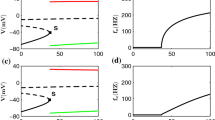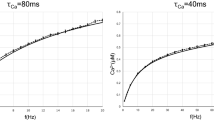Abstract
A leaky integrate-and-fire (LIF) neurons can act as multipliers by detecting coincidences of input spikes. However, in case of input spike trains with irregular interspike delays, false coincidences are also detected and the operation as a multiplier is degraded. This problem can be solved by using time dependent synaptic weights which are set to zero after each input spike and recover with the same time constant as the decay time of the corresponding excitatory postsynaptic potentials (EPSP). Such a mechanism results in EPSP's with amplitudes independent on the input interspike delays. Neuronal computation is then performed without frequency decoding.
Similar content being viewed by others
Abbreviations
- C :
-
Capacitance of the cellular membrane (F)
- Ds :
-
Duration of the spikes and inward current pulse. (s)
- ΔV :
-
Contribution to the capacitor (membrane) potential reached at the end of an input spike at synapse j (V)
- V + :
-
Membrane potential increase due to one input spike at synapse j (V)
- f in :
-
Maximum input frequency (Hz)
- f n :
-
Output frequency of a LIF neuron when n connected inputs fire at their maximum frequency f in . (Hz)
- n :
-
Number of inputs connected to a neuron.
- R :
-
Leak resistance of the membrane (Ohm)
- RC :
-
Discharge time constant of the membrane (= R · C) (s)
- RSD:
-
Relative standard deviation of the interspike intervals (=σ Ti / Ti)
- σ Ti :
-
Standard deviation of the interspike intervals (s)
- S :
-
Selectivity of the LIF neuron as a multiplier.
- τ :
-
Time window for input spikes (s)
- T i :
-
Average interspike interval of the spikes produced by neuron i (s).
- T :
-
Delay between the preceding spike and the spike under consideration (s).
- T in :
-
Average interspike interval corresponding to the maximum input frequency f in (s)
- T r :
-
Duration of the refractory time (starting at same time as an output spike) (s)
- V :
-
Potential of the cellular membrane or the capacitor (V)
- V 0 :
-
Potential remaining from preceding spikes on synapse j (V)
- V th :
-
Threshold potential for spike initiation (V)
- W ij :
-
Time dependent synaptic weight for inputs from neuron j to neuron i. In this model, the synaptic weight is the amplitude of the input current pulse induced by the spike (A).
- W ijo :
-
Time independent synaptic weight according to the theory of the multiplication mode for regular input spike trains with interspike delays Tin (Bugmann 1991c) (A)
References
Bialek W, Rieke F, De RuytervanSteveninck R, Warland D (1991) Reading a neural code. Science 252:1854–1857
Buchanan JT, Moore LE, Hill R, Wallen P, Grillner S (1992) Synaptic potentials and transfer functions of lamprey spinal neurons. Biol Cybern 67:123–131
Bugmann G (1991a) Neural Information carried by one spike. Proceedings of the 2nd Australian Conference on Neural Networks (ACNN' 91), Sydney, pp 235–238
Bugmann G (1991b) Can neurons realize multiple AND-functions? Proceedings of the 4th International Conference on Neural Networks and their Applications (Neuronimes' 91), Nimes, France, pp 757–760
Bugmann G (1991c) Summation and multiplication: two distinct operation domains of leaky integrate-and-fire neurons. Network 2:489–509
Ferster D, Jagadeesh B (1992) EPSP-IPSP Interactions in cat visual cortex studied in vivo whole-cell patch recording. J. Neurosci 12:1262–1274
Hodgkin AL, Huxley AF (1952) A quantitative description of membrane current and its application to conduction and excitation in nerve. J Physiol (London) 117:500–544
Koch C, Poggio T (1992) Multiplying with synapses and neurons. In: Zornetzer S, Davis J, McKenna Th (eds) Single neuron computation. Chap. 12, pp 315–345
Küpfmüller K, Jenik F (1961) Über die Nachrichten Verarbeitung in der Nervenzelle. Kybernetik 1:1–6
Author information
Authors and Affiliations
Rights and permissions
About this article
Cite this article
Bugmann, G. Multiplying with neurons: Compensation for irregular input spike trains by using time-dependent synaptic efficiencies. Biol. Cybern. 68, 87–92 (1992). https://doi.org/10.1007/BF00203140
Received:
Accepted:
Issue Date:
DOI: https://doi.org/10.1007/BF00203140




